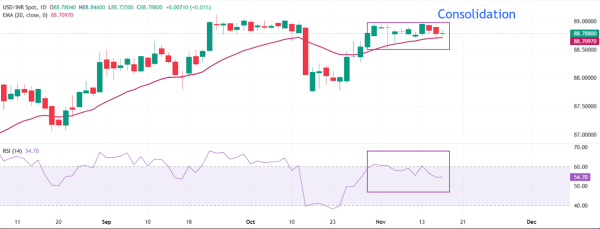The Indian Rupee (INR) opened flat against the US Dollar (USD) on Tuesday, with the USD/INR pair trading in a narrow range around 88.85. Market participants are cautious, adopting a wait-and-watch approach ahead of the highly anticipated US Nonfarm Payrolls (NFP) data for September.
The market remains sensitive to both domestic and international developments, including ongoing India-US trade negotiations and potential shifts in Federal Reserve (Fed) monetary policy. LFtrade professionals unpack the complexities of the issue with a thorough and accessible analysis.
INR Opens Flat Amid Trade Talks
The USD/INR has been consolidating between 88.50 and 89.00 since the start of the month, reflecting limited directional momentum. According to India’s Commerce Secretary Rajesh Agarwal, the higher tariff issue with the US has been “nearly resolved.” This includes the 50% tariffs levied on Indian imports, of which 25% is reciprocal, and the remaining imposed due to India’s purchase of Russian oil.
Research from BofA Securities highlights that India’s exports to the US shrank by 12% in September, mainly due to these elevated tariffs. Recent comments from both US and Indian officials indicate progress toward a bilateral trade deal, with Agarwal stating that the first phase, which addresses tariffs and market access, is almost finalized. The US President has also suggested that a deal is imminent, although a specific time frame remains unclear.
Market Eyes US NFP Data
Investor attention is now squarely on the US labor market, with the Nonfarm Payrolls (NFP) report scheduled for release by the US Bureau of Labor Statistics (BLS) on Thursday. The data is expected to have a significant impact on the USD, influencing market expectations regarding the Fed’s monetary policy trajectory.
Recent months have seen major economic data releases disrupted due to a US government shutdown, heightening anticipation around this NFP release. A strong payroll figure could support the USD, while a weaker print might reinforce dovish Fed expectations, potentially influencing USD/INR volatility.
Fed Officials Signal Mixed Messages
Ahead of the NFP release, Fed officials have highlighted potential risks in the US employment market, adding complexity to trader positioning. Fed Governor Christopher Waller suggested that the Fed may need to cut interest rates in December due to a slowdown in hiring. He noted that firms are investing in AI technology rather than hiring, and household spending is soft, which impacts job growth and supports further interest rate cuts.
Meanwhile, Fed Vice Chair Philip Jefferson acknowledged downside employment risks but cautioned against aggressive rate cuts, noting that policy is approaching a neutral stance. Jefferson stated that the balance of risks has recently shifted, with greater downside potential for employment, but emphasized that the Fed must proceed cautiously as policy approaches a neutral stance.

USD Index Trends
At the time of writing, the US Dollar Index (DXY), which tracks the USD against six major currencies, trades marginally lower near 99.45. The index gained sharply earlier in the week as traders scaled back bets for an additional Fed rate cut.
According to the CME FedWatch Tool, the probability of a 25 basis points (bps) rate cut to 3.50%-3.75% in December has dropped to 43%, down from 62.4% last week, reflecting reduced market expectations for dovish moves.
Technical Analysis: USD/INR Remains Sideways
From a technical perspective, USD/INR remains capped below 89.00, maintaining a tight sideways trend for over two weeks. The 20-day Exponential Moving Average (EMA) near 88.70 continues to provide strong support, serving as a key level for USD bulls.
The 14-day Relative Strength Index (RSI) remains below 60.00, indicating the absence of strong bullish momentum. A decisive move above 60.00 on the RSI could trigger renewed upside potential, with traders likely targeting the all-time high of 89.12 as the next resistance level.
On the downside, the August 21 low of 87.07 represents a critical support level. A breakdown below this point could signal a bearish shift, though current market sentiment remains cautious, awaiting the US NFP data and clarity on trade negotiations.

Conclusion: Range-Bound with Event Risks
In summary, the USD/INR pair is trading within a narrow range as investors adopt a wait-and-see approach. Key factors influencing the pair include ongoing India-US trade negotiations, with tariffs approaching resolution, and the upcoming US Non-Farm Payroll (NFP) data, which is expected to guide expectations for Federal Reserve (Fed) policy. Additionally, the Indian rupee is experiencing limited volatility, reflecting the broader consolidation pattern in the market.
Traders are advised to monitor technical levels closely. A breakout above 89.00 could reignite bullish momentum, while a fall below 88.70 might indicate a short-term correction. Given the event-driven risks, the USD/INR is likely to remain range-bound until concrete signals emerge from both bilateral trade progress and the US labor market.









